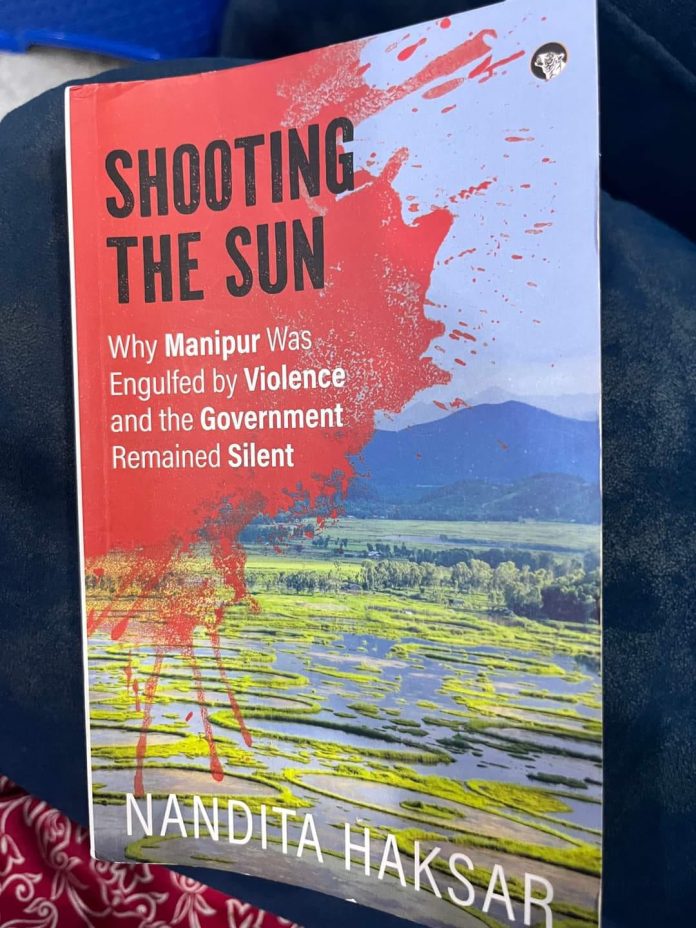Reviewed by Rama Sundari (in Telugu)
Translated into English by Ayesha Sultana
5 August 2024: To understand the complexities of Manipur, one must read Shooting the Sun by Nandita Haksar. Haksar, a renowned human rights lawyer with extensive experience in Northeast India, previously authored notable works such as Across the Chicken Neck and Many Faces of Kashmiri Nationalism. As a Kashmiri Brahmin who married Sebastian Hongray, a Naga Christian from Manipur, she brings a unique perspective to her writings.
Haksar’s deep understanding of the socio-political, economic, and cultural issues of the Northeastern states is evident throughout the book. Her involvement in the Indo-Naga peace talks and her residency in Manipur during tumultuous times enrich her narrative with authenticity and depth.
In Shooting the Sun, Haksar delves into the multifaceted violence in Manipur, drawing from a wide array of sources, including personal interviews, articles, court judgments, and organizational reports. She boldly addresses the restrictions imposed by the Manipur government, which prohibits any documentation of Manipur’s history, culture, and geography.
The first chapter meticulously traces the historical roots of Meitei identity, from their shift from the indigenous Sanamahi religion to Hindu Vaishnavism during the 18th century under King Pamheiba’s reign, facilitated by Hindu missionaries. Haksar notes that in any society, rulers typically convert first, followed by their subjects. Despite this historical transition, around 7% of Meiteis continue to practice the ancient Sanamahi faith.
Haksar examines whether the conflict in Manipur is ethnic or religious, ultimately leaning towards the former, supported by extensive evidence. She highlights that even within the Meitei community, there are Christians, such as the Meitei Christian Church Council, which describes the conflict as one between “Manipuris and illegal immigrants.” This stance is further complicated by the Meitei Christian community’s request to exclude Meitei churches from lists of destroyed churches.
Haksar discusses figures like Roshan Singh, a Meitei Christian leader who, despite his activism on various issues, asserts that the violence in Manipur is not anti-Christian but attributes it to Kukis betraying Christ akin to Judas. While acknowledging that religious animosity cannot be entirely dismissed, Haksar provides instances suggesting that economic factors, drug trafficking, and insurgent fears also play significant roles. She cites the US-based Indian Diaspora Studies Centre’s view that, despite religious divisions, the conflict in Manipur has not primarily been religious violence.
In the chapter “Who Are the Outsiders,” Haksar presents clear demographic statistics. Kukis, who numbered 284,488 in 1901, grew to 448,214 by 2011, a modest increase of 2% over 110 years. In 2023, Kukis were suddenly labeled as “outsiders,” a designation she argues is unwarranted, as Myanmar refugees who have obtained asylum status from the UNHCR are distinct from the Kuki residents of Manipur. She points out that Mizoram, for instance, has provided shelter to around 40,000 such refugees.
Haksar provides a detailed account of how poppy cultivation has become central to political power in Manipur. She traces its origins to the Kuomintang party members who fled China after the revolution and began poppy cultivation in the Golden Triangle (Burma-Thai border). Drawing parallels to the US’s war on drugs criminalizing African-Americans, she argues that the Manipur government under Biren Singh has similarly criminalized the Kukis. She eloquently connects poverty with poppy cultivation, illustrating its socio-economic dimensions.
Furthermore, Haksar explores the involvement of Chinese nationalist mafias in Myanmar’s drug trade, implying potential future influence over Manipur’s political landscape. She echoes the concerns of former Manipur SP Thounaojam Brinda that if Chinese forces begin to control Manipur’s political figures, the conflict will persist as long as elections are driven by money from the drug mafia.
Haksar also touches upon the conflict between Kukis and Nagas, emphasizing that these disputes are not primarily caused by individuals but by political forces exploiting geographical and ethnic divisions. In this volatile region, even minor provocations can escalate into major conflicts.
Shooting the Sun is an insightful and meticulously researched book that sheds light on the intricate and often misunderstood dynamics of Manipur. Haksar’s detailed narrative and comprehensive analysis make it an essential read for anyone seeking to understand the region’s complexities.




